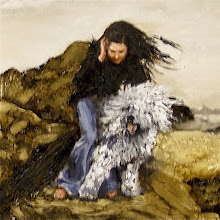
The title of the painting, Ora et Labora, is Latin for Pray and work.
From left to right, I'll list the symbols as they pertain to the individual:
Nun #1 - The Crane: Loyalty, Monastic life. Ivy wreath: hospitality. Lamp: Wisdom.
Nun #2 - Columbine flower: Holy Spirit. Snow: Purity, innocence. Heart: love and charity.
Nun #3 - Scallop shell: Pilgrim. Bee: hard work. Potter's wheel: being formed by God.
Nun #4 - Butterfly: new life. Fern: solitude, humility and sincerity. Sunflower: keeping our eyes fixed on Jesus.
The colors have meaning also. Gold: worth. Blue: wisdom and charity. Green: growth, life, hope. Red: love, holy zeal.
In the background are wheat fields. Wheat has always represented the Holy Eucharist which is what the Catholic faith is centered around.












